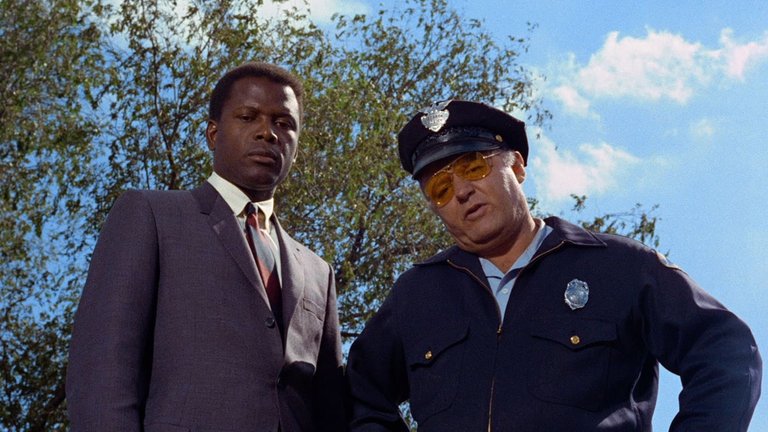
Hollywood’s contemporary fixation with positioning itself on the “right side of history” often manifests in heavy-handed narratives that prioritise moral posturing over nuanced storytelling. Recent efforts to address social issues frequently descend into didacticism, alienating audiences with their sanctimonious tone—a stark contrast to mid-20th-century cinema, which wove progressive themes into gripping plots without patronising viewers. A prime example of this subtler approach is Norman Jewison’s 1967 crime thriller In the Heat of the Night. While undeniably a product of its time, the film transcends mere political commentary through its layered characters, taut suspense, and refusal to simplify the complexities of racial prejudice. Celebrated upon release as both a critical and commercial triumph (garnering five Academy Awards, including Best Picture), the film remains a masterclass in addressing societal divides through narrative restraint rather than sermonising—a quality that underscores its enduring relevance.
Based on John Ball’s 1965 novel, the screenplay by Stirling Silliphant retains the source material’s central conflict—a Black detective navigating a hostile Southern town—while amplifying its racial tensions for cinematic impact. Set in fictional Sparta, Mississippi, the plot unfolds as a microcosm of America’s broader civil rights struggles, with the murder of industrialist Phillip Colbert exposing the town’s entrenched bigotries. The decision to adapt Ball’s novel during the height of the civil rights movement was no accident; 1967 saw the passage of the Voting Rights Act and escalating racial violence, making the film’s release both timely and provocative.
The narrative thrust hinges on an unlikely partnership between Virgil Tibbs (played by Sidney Poitier), a polished Philadelphia homicide detective, and Chief Bill Gillespie (played by Rod Steiger), Sparta’s brash, prejudiced police chief. When Tibbs is mistakenly arrested at a train station—his possession of cash brands him a suspect in Colbert’s murder—his revelation as a skilled investigator forces Gillespie into a reluctant collaboration. Tibbs’ expertise becomes indispensable, particularly under pressure from Colbert’s widow (played by Lee Grant), a Northern progressive demanding justice. What follows is less a whodunit than a searing exploration of systemic racism, as Tibbs’ methodical investigation peels back the veneer of Southern gentility to reveal a community steeped in hypocrisy and violence.
The film unflinchingly deploys stereotypes of the South as a bastion of ignorance, framing Sparta’s residents as crude and hostile, particularly in contrast to Tibbs’ urbane intellect. Yet this caricature serves a deliberate purpose: by magnifying the region’s prejudices, the script underscores the absurdity of racial hierarchies. The town’s outrage at being outwitted by a Black man—a figure they deem inherently inferior—becomes a scathing indictment of white supremacy. One pivotal scene encapsulates this dynamic: when Tibbs slaps plantation owner Eric Endicott (played by Larry Gates) after enduring a racist insult, the act defies decades of subservience expected of Black Americans. Though unprofessional, Tibbs’ retaliation is cathartic, symbolising a broader refusal to accept victimhood—a radical assertion of dignity in the face of dehumanisation.
Gillespie’s arc from bigot to begrudging ally forms the film’s emotional core. Initially dismissive of Tibbs, Steiger’s Oscar-winning portrayal subtly charts the chief’s growing respect for his counterpart’s competence. His intervention during the Endicott confrontation—calmly diffusing tension rather than siding with the white aristocrat—signals a seismic shift in his worldview. By the film’s close, Gillespie’s gruff acknowledgement of Tibbs (“Take care, you hear?”) speaks volumes, suggesting a camaraderie forged through shared purpose. Similarly, Warren Oates’ Officer Sam Wood evolves from suspicion to uneasy respect, embodying the possibility of individual growth even within a corrupt system.
Poitier’s performance is a study in controlled intensity; his Tibbs exudes authority without veering into sanctimony, balancing vulnerability with steely resolve. Steiger matches him with a textured turn, his Gillespie oscillating between bluster and introspection. Their chemistry elevates the film beyond procedural tropes, grounding its social commentary in human relationships. Supporting roles—notably Scott Wilson as a troubled mechanic and Anthony James as a venomous diner worker—add depth to Sparta’s morally fraught landscape.
Haskell Wexler’s Oscar-winning cinematography employs shadow and light to mirror the narrative’s moral contrasts. His pioneering use of lighting techniques—particularly in rendering Poitier’s complexion with naturalism—challenged industry norms that traditionally marginalised Black actors. Quincy Jones’ score, blending jazz rhythms with Southern motifs, amplifies the tension without overpowering scenes, while Ray Charles’ haunting theme song, “In the Heat of the Night,” underscores the film’s melancholic undertones.
The film’s success spawned two sequels—They Call Me Mister Tibbs! (1970) and The Organization (1971)—though neither recaptured the original’s socio-political urgency, retreating into conventional crime tropes. A 1988 TV revival, starring Howard Rollins and Carroll O’Connor, extended Tibbs’ legacy but softened the racial critique for prime-time audiences. While the film’s portrayal of the South risks reductiveness, its core message—that progress, however incremental, is achievable through confrontation and empathy—resonates across decades.
In the Heat of the Night succeeds where modern “message films” often falter: it trusts its audience to grapple with uncomfortable truths without didactic finger-wagging. By embedding its racial critique within a compelling mystery and complex character dynamics, Jewison crafts a work that is as intellectually provocative as it is entertaining. In an era where Hollywood’s well-intentioned but clumsy activism frequently alienates, the film stands as a testament to the power of subtlety—a reminder that change is best illuminated through stories, not sermons.
RATING: 8/10 (+++)
Blog in Croatian https://draxblog.com
Blog in English https://draxreview.wordpress.com/
InLeo blog https://inleo.io/@drax.leo
Hiveonboard: https://hiveonboard.com?ref=drax
InLeo: https://inleo.io/signup?referral=drax.leo
Rising Star game: https://www.risingstargame.com?referrer=drax
1Inch: https://1inch.exchange/#/r/0x83823d8CCB74F828148258BB4457642124b1328e
BTC donations: 1EWxiMiP6iiG9rger3NuUSd6HByaxQWafG
ETH donations: 0xB305F144323b99e6f8b1d66f5D7DE78B498C32A7
BCH donations: qpvxw0jax79lhmvlgcldkzpqanf03r9cjv8y6gtmk9
Posted Using INLEO